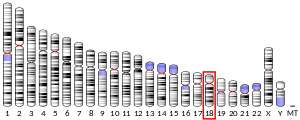ZNF24
Zinc finger protein 24 is a protein that in humans is encoded by the ZNF24 gene.[5]
References
Further reading
- Rousseau-Merck MF, Huebner K, Berger R, Thiesen HJ (January 1991). "Chromosomal localization of two human zinc finger protein genes, ZNF24 (KOX17) and ZNF29 (KOX26), to 18q12 and 17p13-p12, respectively". Genomics. 9 (1): 154–61. doi:10.1016/0888-7543(91)90233-5. PMID 2004757.
- Thiesen HJ (April 1990). "Multiple genes encoding zinc finger domains are expressed in human T cells". The New Biologist. 2 (4): 363–74. PMID 2288909.
- Williams AJ, Blacklow SC, Collins T (December 1999). "The zinc finger-associated SCAN box is a conserved oligomerization domain". Molecular and Cellular Biology. 19 (12): 8526–35. PMC 84969. PMID 10567577.
- Han ZG, Zhang QH, Ye M, Kan LX, Gu BW, He KL, Shi SL, Zhou J, Fu G, Mao M, Chen SJ, Yu L, Chen Z (December 1999). "Molecular cloning of six novel Krüppel-like zinc finger genes from hematopoietic cells and identification of a novel transregulatory domain KRNB". The Journal of Biological Chemistry. 274 (50): 35741–8. doi:10.1074/jbc.274.50.35741. PMID 10585455.
- Reuter TY, Medhurst AL, Waisfisz Q, Zhi Y, Herterich S, Hoehn H, Gross HJ, Joenje H, Hoatlin ME, Mathew CG, Huber PA (October 2003). "Yeast two-hybrid screens imply involvement of Fanconi anemia proteins in transcription regulation, cell signaling, oxidative metabolism, and cellular transport". Experimental Cell Research. 289 (2): 211–21. doi:10.1016/S0014-4827(03)00261-1. PMID 14499622.
- Gocke CB, Yu H, Kang J (February 2005). "Systematic identification and analysis of mammalian small ubiquitin-like modifier substrates". The Journal of Biological Chemistry. 280 (6): 5004–12. doi:10.1074/jbc.M411718200. PMID 15561718.
- Rush J, Moritz A, Lee KA, Guo A, Goss VL, Spek EJ, Zhang H, Zha XM, Polakiewicz RD, Comb MJ (January 2005). "Immunoaffinity profiling of tyrosine phosphorylation in cancer cells". Nature Biotechnology. 23 (1): 94–101. doi:10.1038/nbt1046. PMID 15592455.
- Zhao DX, Ding ZC, Liu YQ, Huang ZX (May 2007). "Overexpression and purification of single zinc finger peptides of human zinc finger protein ZNF191". Protein Expression and Purification. 53 (1): 232–7. doi:10.1016/j.pep.2006.12.009. PMID 17270462.
External links
- ZNF24+protein,+human at the US National Library of Medicine Medical Subject Headings (MeSH)
This article incorporates text from the United States National Library of Medicine, which is in the public domain.
This article is issued from
Wikipedia.
The text is licensed under Creative Commons - Attribution - Sharealike.
Additional terms may apply for the media files.







